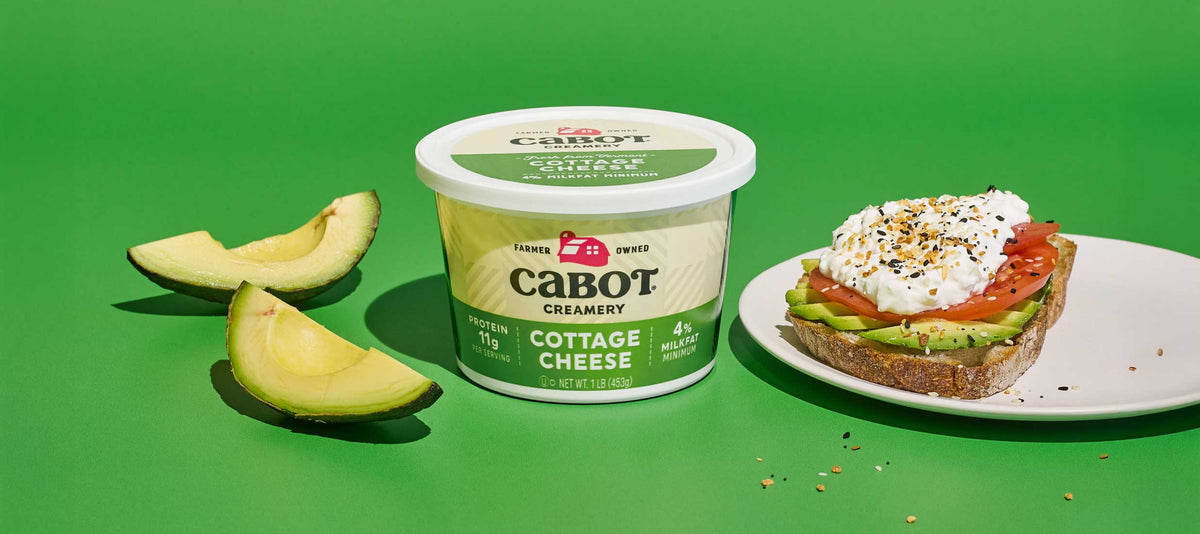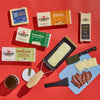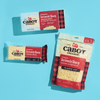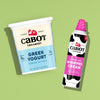
How to get 30 grams of protein for breakfast, according to an RD
Brierley Horton, M.S., RD is a dietitian nutritionist, content creator and strategist, and avid mental health advocate. She is co-host and co-creator of the Happy Eating podcast, which breaks down the connection between food and mental wellness.
We are a nation in love with protein! A recent survey reported that the most popular “diet” or eating pattern among surveyed Americans was a high-protein diet.
And, despite what you may have seen in some news headlines, our focus on protein isn’t a bad thing. Protein has so many benefits: gram for gram it’s more satisfying than fat or carbohydrates. When you eat protein-rich foods, you’re also getting key nutrients that many of us Americans typically fall short on. For example, our Cabot Greek yogurt delivers vitamin D. Our Cabot cheeses offer healthy doses of calcium. Choosing beef is one of the best ways to get more iron into your diet. And all animal proteins (think: chicken, turkey, pork, etc.) are the only way to get vitamin B12.
But how much protein should you aim to eat each day? And what should you breakfast look like?
How Much Protein to Eat at Breakfast
You’ve probably heard that you should aim for 0.8 grams of protein per kilogram of body weight each day, right? While that’s not wrong, there’s a minor detail often overlooked in that explanation. That recommendation is based on the average amount of protein needed to prevent lean body mass loss—aka not lose muscle. The key words are not lose muscle.
If you are an active person or if you want to gain muscle, you need more protein. In fact, the recommendation for active adults ranges from 1.2 to 2 grams of protein per kilogram of body weight per day. So, for example, a 150-pound person should aim for 82 to 136 grams of protein per day.
Another fact about protein that isn’t shared all that often is this: your body does a poor job of saving extra protein for later. Meaning, if at a meal you eat more protein than your body can synthesize and use, it doesn’t save that extra protein for when it will need it later. It sends it off to be stored as fat. This is why you want to spread out your protein intake throughout the day. But most of us excel at skimping on protein at breakfast and loading up on protein later in the day.
When you look at the scientific research, you’ll see that the general recommendation is to aim to eat 25 to 35 grams of protein at each meal. And if you read health-focused articles, you’ll see the general recommendation is usually 30 grams at each meal. As a registered dietitian, I don’t think there’s anything particularly magical to the “30 grams of protein at each meal” advice, but that’s what a lot of the research is rooted in and the research shows it works. Spreading your protein out evenly across your meals and aiming for 25 to 35 grams at each meal has been shown to help temper afternoon and evening food cravings; it helps build muscle more successfully than a protein-heavy dinner; and it helps with weight loss.
So, with this new information, what does 30 grams of protein at breakfast look like? Is it doable? It is! Let’s get you started with these high-protein breakfast ideas:
5 Protein Foods for Breakfast
Ricotta Waffles with Berries (30g protein)
3 high-protein waffles (e.g., Eggo, Kodiak Cakes, Birch Benders) (18g protein)
3 tablespoons ricotta (6g protein)
½ cup maple syrup, divided
1 tablespoon peanut butter (4g protein)
½ cup mixed berries (2g protein)
Toast the high-protein waffles according to the package instructions. Microwave peanut butter and half of the maple syrup together in 15 second increments until the mixture is pourable. Top each waffle with a tablespoon of ricotta, half of the berries, and pour maple syrup and peanut butter mixture on top. Use the remaining maple syrup as needed.
Cottage Cheese & Nut Butter Chia Bowl (35g protein)
1 cup Cabot cottage cheese (28g protein)
1 tbsp almond butter (3g protein)
2 teaspoons chia (2g protein)
1 Tbsp honey
½ cup fresh or frozen berry of choice (2g protein)
In a medium-sized bowl, layer the ingredients in order of how they are listed (cottage cheese first, berries last). Stir, if desired, and enjoy!
Salmon & Avocado Bagel (33g protein)
1 bagel (8-13g protein)
2-3 ounces smoked salmon (10-15g protein)
3 Tbsp Cabot cream cheese, divided (3g protein)
½ avocado, optional (2g protein)
Pro Protein Tip: Look for the brand Dave Killer’s Bread when choosing your bagel flavor. Their bagels deliver 11 to 13 grams of protein per bagel, whereas most other national brands deliver 8 to 9 grams protein per serving.
If desired, toast the bagel. Then spread 1½ tablespoons cream cheese on each half. Top with salmon and, if desired, avocado.
Breakfast Burrito Bowl (37g protein)
3 large eggs (18g protein)
½ cup cooked brown rice (3 grams)
½ cup canned black beans, drained and rinsed (7g protein)
¼ cup Cabot shredded cheese (7g protein)
½ avocado (2g protein)
2 Tbsp pico de gallo
Pro Protein Tip: Cook your rice in bone broth for an extra boost of protein. One cup of bone broth typically contains about 8 to 10 grams protein.
Cook eggs in the style you prefer most. For this burrito bowl, we recommend scrambled or fried. While your eggs cook, layer rice and black beans in a bowl. Top with your cooked eggs, shredded cheese, avocado, and pico de gallo.
Greek Yogurt Protein Bowl (28g protein)
1 cup Cabot Greek yogurt (17-21g protein)
2 Tbsp hemp hearts (6g protein)
¼ cup fresh or frozen mixed berries (1g protein)
Maple syrup to taste (optional)
Pro Protein Tip: Turn this into a high-protein smoothie bowl by increasing the berries amount to ½ cup and using frozen berries. Add berries and yogurt to a blender, plus add a scoop of your favorite protein powder (10-15g protein). While blending, slowly add a liquid of your choice in ¼ cup increments until you reach a desired consistency. Pour in a bowl and top with hemp seeds.
In a medium-sized bowl, top yogurt with hemp seeds, berries, and maple syrup (if using). Stir, if desired, and enjoy!
More Ideas for What 30 Grams Protein (Generally Speaking) Looks Like
Once you know how much protein is in a common serving of a protein-rich food, it’s easy to build a meal (or even a snack) that adds up to 30 grams of protein. Get some inspiration from this list!
|
1 serving Cabot Cracker Cuts (4 slices) |
8g |
|
1 serving Cabot Greek Yogurt (3/4 cup) |
14g |
|
1 serving Cabot Cottage Cheese (1/2 cup) |
11g |
| 1 ounce pistachios | 6g |
| 2 Tablespoons peanut butter | 8g |
| ½ cup black beans | 8g |
| ½ cup lentils | 12g |
| ½ cup edamame | 9g |
| 4 ounces shrimp (about 5 large or jumbo) | 24g |
| 6-ounce filet salmon | 38g |
| 4 ounces canned tuna (about 1 can drained) | 30g |
| 4 ounces pork chop | 30g |
| 4 ounces chicken | 30g |
| 4 ounces grass-fed steak | 24g |
| 4 ounces ground turkey | 22g |
| 1 cup bone broth | 10g |

















